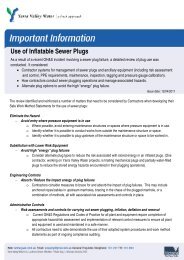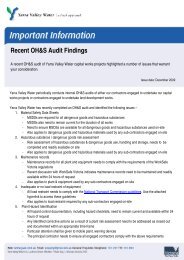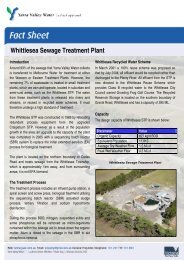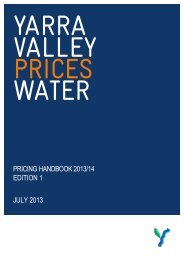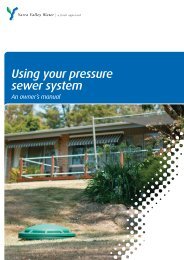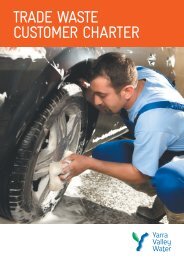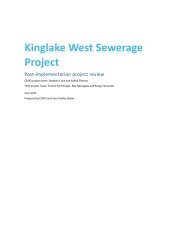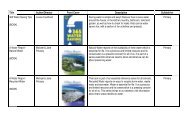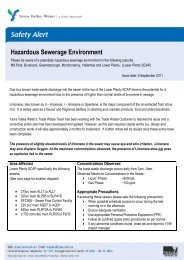The Pipeline - Issue one - Yarra Valley Water
The Pipeline - Issue one - Yarra Valley Water
The Pipeline - Issue one - Yarra Valley Water
Create successful ePaper yourself
Turn your PDF publications into a flip-book with our unique Google optimized e-Paper software.
<strong>The</strong> <strong>Pipeline</strong><br />
<strong>Issue</strong> One April 2006<br />
A Melbourne Retail <strong>Water</strong> Agency<br />
Newsletter for Property Developers,<br />
Consultants and Contractors<br />
Welcome………<br />
This is the first edition of ‘<strong>The</strong> <strong>Pipeline</strong>’, a bi-annual newsletter, which has been<br />
designed to provide you with an update on the latest industry developments,<br />
issues and news.<br />
‘<strong>The</strong> <strong>Pipeline</strong>’ is a joint Melbourne Retail <strong>Water</strong> Agency (MRWA) initiative and is<br />
available at all three MRWA websites (click on the logo links below).<br />
Importantly, we are also looking for your involvement in future editions and invite your<br />
input on any issue you may like to be addressed, or if you have any suggestions on how<br />
we can further improve ‘<strong>The</strong> <strong>Pipeline</strong>’.<br />
We hope that you find this issue informative and that you subscribe to future editions.<br />
What’s New & Changed<br />
Standards Update<br />
WSAA Codes – Minor Amendments<br />
<strong>The</strong> MRWA’s Edition of the <strong>Water</strong> Services<br />
Association of Australia (WSAA), <strong>Water</strong><br />
Supply and Sewerage Codes have been in<br />
place for some 12 months.<br />
<strong>The</strong>se Codes are being reviewed by the<br />
MRWA’s to ensure that they are up to date.<br />
Once completed, details of changes and<br />
minor amendments will be forwarded to<br />
organisations that have registered with<br />
WSAA as a Code subscriber.<br />
Tip:<br />
Make sure you register with WSAA by<br />
simply filling in the subscription form when<br />
purchasing each Code.<br />
Maintenance Hole Ladder Brackets<br />
Property developers, consultants and<br />
contractors are reminded that ladder<br />
brackets are to be installed flush against the<br />
curved walls of the Maintenance Hole.<br />
Appropriately angled brackets are available<br />
from suppliers. However, it is suggested<br />
that care be taken when ordering brackets.<br />
This is to ensure that the supplier knows<br />
what they are intended to be used for so<br />
that the correct angled bracket is supplied.<br />
Note:<br />
90º brackets stand proud of the<br />
Maintenance Hole wall and are therefore<br />
not acceptable.<br />
Use of Maintenance Shafts<br />
<strong>The</strong> MRWA’s are keen to promote the use<br />
of Maintenance Shafts within the<br />
sewerage system.<br />
Maintenance Shafts (MS) are designed to<br />
be used as an alternative to sewer<br />
Maintenance Holes (MH) and have the<br />
potential to reduce cost to the developer,<br />
reduce OH&S construction risks to<br />
contractors and minimise entry into live<br />
sewers.<br />
Details of the design principles, approved<br />
products and materials and installation<br />
arrangements are defined in the MRWA<br />
Edition of the WSAA Sewerage Code<br />
(WSA 02-2002).<br />
Note:<br />
<strong>The</strong> MRWA’s are currently preparing a<br />
Technical Note for MS design and<br />
installation guidelines. This is being<br />
developed to encourage the use of MS<br />
in sewer reticulation works, especially in<br />
new developments. Once completed it<br />
will be made available to industry.<br />
See also<br />
City West <strong>Water</strong> demonstration project<br />
www.citywestwater.com.au<br />
…… continued next page<br />
In this <strong>Issue</strong><br />
Standards Update<br />
• WSAA Codes<br />
• Maintenance Hole<br />
Ladder Brackets<br />
• Use of Maintenance Shafts<br />
• Quarry Products<br />
• <strong>Water</strong> Quality in Court Bowls<br />
• Valving Within Shared Trenches<br />
• Approved Products Catalogues<br />
• Auditing Checklists<br />
• Backfill Specification<br />
• Improving Maintenance Hole<br />
Table Design and Construction<br />
• Welding Specifications<br />
Standards Alert<br />
• Dual <strong>Water</strong> Standards<br />
Safety Alerts<br />
• Compliance with the New OH&S<br />
Act 2004<br />
• Stringing Pipes Along Roadways<br />
•Electrification of Metallic<br />
<strong>Water</strong> Pipes<br />
Coming Events<br />
Training/Workshops<br />
Disinfection of <strong>Water</strong> Mains<br />
<strong>The</strong> MWRA’s, together with the<br />
<strong>Water</strong> Industry Training Centre at<br />
Deakin University, Belmont have<br />
established an accredited<br />
contractor training course for the<br />
Disinfection of <strong>Water</strong> Mains.<br />
Currently, there is limited access<br />
to approved contractors to carry<br />
out disinfection of water mains.<br />
Any contractor interested in<br />
undertaking this activity is<br />
encouraged to sign up for the<br />
course, as only accredited<br />
personnel will be able to carry<br />
out these works in the near<br />
future. Contact your nearest<br />
MWRA (see back page) for<br />
details of the course.
<strong>The</strong> <strong>Pipeline</strong><br />
What’s New & Changed<br />
…continued<br />
Quarry Products<br />
Since 1995, all suppliers of quarry<br />
products, which includes embedment<br />
sand, have been required to have ISO<br />
accreditation.<br />
Tip:<br />
When ordering quarry products remember<br />
that the current WSAA Purchase<br />
Specifications, requires suppliers to have<br />
ISO 9001 accreditation.<br />
<strong>Water</strong> Quality in Court Bowls<br />
<strong>The</strong> MRWA Edition of the WSAA <strong>Water</strong><br />
Code includes a standard drawing for<br />
court bowl installations (WAT-1121-M).<br />
Detail C of the Code specifies the MRWA’s<br />
requirements for connecting the 100mm<br />
main to a courts 63mm/50mm diameter<br />
pipe.This detail has been introduced to<br />
minimise the possible build-up of silt within<br />
water mains and associated water quality<br />
issues within court bowls.<br />
Alert:<br />
Note 11 on this drawing includes an<br />
error. <strong>The</strong> MRWA’s require all<br />
sub-mains to terminate in a flushing<br />
assembly regardless of diameter.<br />
Valving Within Shared Trenches<br />
<strong>The</strong> MRWA’s Edition of the WSAA<br />
<strong>Water</strong> Supply Code includes a slight<br />
change to past practice to valves<br />
installed within shared trenches.<br />
An extract from Section 4.4 of the Code<br />
states - (h) valve types, that only FL-FL<br />
valves are permitted in shared trenching<br />
conditions (socketed or spigotted valves<br />
are not permitted).<br />
<strong>The</strong> adopted change has been<br />
introduced to ensure that valving<br />
installed within wider than normal<br />
trenches will not leak or move when<br />
opened or closed during normal<br />
operations and maintenance.<br />
Note:<br />
Any request for concession should be<br />
referred to the MRWA’s prior to any<br />
installation proceeding.<br />
Approved Products Catalogues<br />
Each of the MRWA’s maintain their own<br />
Approved Products Catalogues. <strong>The</strong>se<br />
catalogues are periodically and<br />
independently revised by each of the<br />
MWRA’s. Each of the MWRA’s will inform<br />
the Consulting Engineers and the Civil<br />
Contractors Federation when this occurs.<br />
Tip:<br />
All contractors and consultants are<br />
encouraged to familiarise themselves with<br />
these lists, which are available at each of<br />
the MWRA’s websites.<br />
Auditing Checklists<br />
<strong>The</strong> MRWA’s have recently revised their<br />
own <strong>Water</strong> Supply and Sewer Design<br />
Construction Checklists. This is to ensure<br />
that they are consistent with the MRWA<br />
edition of the WSAA <strong>Water</strong> Supply and<br />
Sewerage Codes.<br />
Copies of Checklists are available at each<br />
of the MRWA’s websites.<br />
Standard Alert<br />
Dual <strong>Water</strong> Supply Systems<br />
Supplement to <strong>Water</strong> Supply<br />
Code of Australia<br />
(MRWA Edition WSA 03-2002-2.3)<br />
<strong>The</strong> first edition of the Dual <strong>Water</strong><br />
Supply System Supplement for the<br />
design and construction of dual<br />
water systems has now been<br />
published by the WSAA.<br />
However, the supplement does not<br />
address all of the MRWA’s<br />
requirements. Consequently, the<br />
MRWA’s have revised this<br />
supplement to communicate<br />
differences between local practice<br />
and generally accepted norms for<br />
the water industry as presented by<br />
WSAA.<br />
Note:<br />
<strong>The</strong> document is currently being<br />
circulated for comment by industry.<br />
Backfill Specification<br />
<strong>The</strong> independent review of the Backfill Specification has been completed after<br />
consultation with the Urban Development Institute of Victoria (UDIV) and the<br />
Association of the Land Development Engineers. This review also incorporates<br />
the recent views of the consultant engaged by the UDIV.<br />
At the recent <strong>Water</strong> Industry Liaison Committee meeting, it was agreed that all<br />
projects under construction on or after 1 September 2006 shall be backfilled in<br />
accordance this MWRA specification<br />
Improving Maintenance Hole Table Design/Construction<br />
A lack of table design is resulting in the construction of Maintenance Holes that<br />
do not meet current standards across new developments.<br />
Designers are encouraged to raise the standard of Maintenance Hole table<br />
design and construction by considering minimum table widths and channel radii,<br />
the possible offset of maintenance holes and/or upsizing them where<br />
necessary.<br />
<strong>The</strong> construction of Maintenance Hole tables could be further improved in some<br />
instances. Contractors are reminded to be aware of “dummy” channels, the<br />
shape and direction of channels and minimum channel radii when constructing<br />
Maintenance Hole tables. Channels are to be formed with polystyrene blocks<br />
and not formed by hand.<br />
Welding Specifications<br />
<strong>The</strong> MRWA’s are currently developing a new welding specification. Watch<br />
out, as this is likely to be finalised within the next few months and will be<br />
distributed to industry once completed.
<strong>The</strong> <strong>Pipeline</strong><br />
Safety Alerts<br />
Compliance with the New<br />
Occupational Health and Safety<br />
(OH&S) Act, 2004<br />
All designers, contractor<br />
superintendents and project managers<br />
should familerise themselves with the<br />
requirements of the new OH&S Act<br />
2004, which came into force on 1 July<br />
2005.<br />
<strong>The</strong> MRWA’s have adopted policies,<br />
processes and practices to manage<br />
compliance with this legislation. In<br />
addition, the MRWA’s have an<br />
obligation to ensure that all parties<br />
associated with any works that will<br />
ultimately be operated and/or<br />
maintained by the MRWA’s fulfil these<br />
new obligations.<br />
Over the past four years the MRWA’s<br />
have recorded OH&S compliance and<br />
have identified several potential areas<br />
of improvement in consultant/contractor<br />
OH&S process and practice.<br />
As a result, strategies are being<br />
developed to audit, monitor and report<br />
on consultant design/project<br />
management and contractor installation<br />
performance against the defined OH&S<br />
regulations and requirements.<br />
This process is expected to manifest itself<br />
through the review of adopted consultant<br />
and contractor systems.<br />
<strong>The</strong> intent of this approach is focused<br />
primarily on defining OH&S opportunities<br />
for improvement.<br />
However, it should be noted that<br />
significant breaches of the legislative<br />
requirements and regulations will incur<br />
corrective actions, and organisations not<br />
able to demonstrate process improvement<br />
will be the focus of future auditing.<br />
Further information regarding the new<br />
OH&S Act 2004 can be obtained from<br />
the Worksafe website at:<br />
www.worksafe.vic.gov.au<br />
Stringing Pipes Along Roadways<br />
It has recently been reported that during<br />
construction of a Hunter <strong>Water</strong> (NSW)<br />
water main a vehicle struck a ductile iron<br />
(DI) pipe, which had been previously laid<br />
out along the roadway.<br />
This is an important reminder to ensure<br />
that appropriate safety measures and<br />
procedures are in place when stringing<br />
pipes along roadways.<br />
Electrification of Metallic <strong>Water</strong><br />
Pipes<br />
In January 2005, a water industry<br />
employee died after receiving an electric<br />
shock during repairs on a main to meter<br />
water service.<br />
In March 2005, a water industry employee<br />
sustained minor injuries after receiving an<br />
electric shock when a clamp device was<br />
mistakenly applied to a power service.<br />
<strong>The</strong>se are not isolated incidents but<br />
highlight the need for maintaining<br />
vigilance when working with metallic<br />
pipes.<br />
In response, Safety Alerts highlighting<br />
the potential hazard for Electrocution<br />
from Work on Metallic Pipes have<br />
been issued.<br />
<strong>The</strong> Alert defines a list of minimum<br />
requirements for any<strong>one</strong> working on<br />
MWRA metallic pipes connecting -<br />
properties or up to 300 mm in<br />
diameter.<br />
<strong>The</strong> Alert is relevant to all contractors<br />
and developers conducting water<br />
main to meter repairs and<br />
replacement or maintenance activities<br />
on existing metallic pipes. It is critical<br />
that all contractors and developers<br />
review work procedures and adopt<br />
the measures outlined in the Safety<br />
Alert as minimum requirements.<br />
Further Information<br />
City West <strong>Water</strong>: Carl Radford<br />
Tel: (03) 9313 8592<br />
Email: cradford@citywestwater.com.au<br />
Web: www.citywestwater.com.au<br />
South East <strong>Water</strong>: David Moore<br />
Tel: (03) 9552 3651<br />
Email: david.moore@sewl.com.au<br />
Web: www.southeastwater.com.au<br />
<strong>Yarra</strong> <strong>Valley</strong> <strong>Water</strong> : Kevin Dawson<br />
Tel: (03) 9872 1474<br />
Email: kevin.dawson@yvw.com.au<br />
Web:www.yvw.com.au<br />
Next <strong>Issue</strong><br />
To make sure that you receive your<br />
next issue of ‘<strong>The</strong> <strong>Pipeline</strong>’ why not<br />
sign-up to receive it directly to your<br />
home computer.<br />
To register or for further information<br />
email:<br />
thepipeline@sewl.com.au<br />
Privacy…please<br />
Please use the following links to<br />
view the various MWRA’s privacy<br />
policies:<br />
City West <strong>Water</strong>:<br />
South East <strong>Water</strong>:<br />
<strong>Yarra</strong> <strong>Valley</strong> <strong>Water</strong>:



